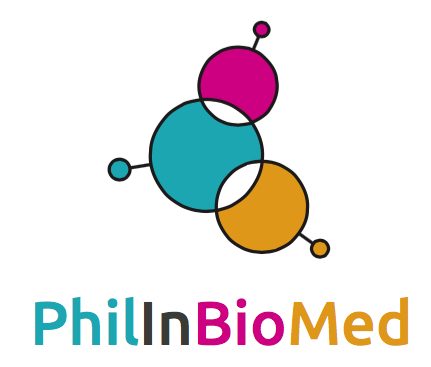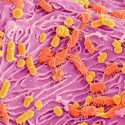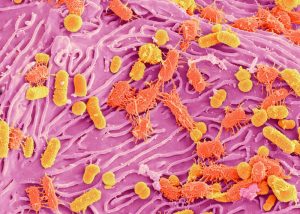How does the microbiome promote or inhibit cancer development?
Quick overview:
- Postdoc position available now (starting from June 2022)
- Funding: Moore Foundation
- PI: Thomas Pradeu (CNRS Research Director, ImmunoConcEpT, University of Bordeaux, France)
- Duration: 3 years, starting from the end of 2022 or the beginning of 2023
- Location: Bordeaux, France, in a thriving interdisciplinary environment, constituted by the Conceptual Biology and Medicine team embedded in a biology lab and the broader PhilInBioMed international network.
- Candidate’s profile: both philosophers of science interested in contributing to biology and medicine and biologists or medical doctors interested in conceptual and theoretical approaches are welcome to apply.
- Salary: CNRS standard postdoc salaries (the exact amount depends on the previous experience of the applicant)
- Main question of the research project: How does the microbiome influence cancer development and progression across different species?
- If you are interested, please contact Thomas Pradeu.
- Application: please send to Thomas Pradeu:
- A CV
- A letter of motivation, where you explain why you apply and what specific project you would conduct
- Two letters of recommendation (they should be sent directly to Thomas Pradeu by the people who recommend you).
- If appropriate, a text of yours that you like (it can be an article, a dissertation chapter, a draft, etc.)
Detail project description:
- State of the art & gaps: there is a long history of considering microbes (e.g., oncogenic viruses) as a possible cause of cancer in humans (e.g., (White et al., 2014)). Recently, though, a protective role of the microbiome against some cancers has been established (Zitvogel et al., 2017), and microbes have been found within tumors, challenging the dogma of tumor sterility (Nejman et al., 2020; Poore et al., 2020). Interestingly, complex and unexpected interactions between the microbiome and cancer have been found across species. For example, tumor formation in Hydra is induced by an environmental spirochete, in relation with the presence of a member of Hydra’s beneficial microbiome (the Pseudomonas bacterium) and the tissue homeostasis (Rathje et al., 2020). The influence of the microbiome on cancer can be local or distant, beneficial or detrimental, and it often occurs via complex interactions not just with the tumor itself but also with the tumor microenvironment (Laplane et al., 2019). How the microbiome can, depending on the context, promote or inhibit cancer has become a central question in recent biomedical literature (Sepich-Poore et al., 2021; Sholl et al., 2022), but fully addressing this question will require combining insights from recent medical research with more basic conceptual and theoretical work in biology.
- Driving Questions or Hypotheses: in this project, we ask if the probability of tumor development in a given tissue is associated with the way in which the microbiome constructs a local niche in that tissue. Our aim, therefore, is to use theories coming from ecology and evolution, most centrally niche construction theory (Odling-Smee et al., 2003), to shed light on the dialogue between the microbiome and cancer. Here, we will understand niche construction broadly as the set of processes by which living things (here, microbes) modify their environment in ecologically and evolutionarily relevant ways. Crucially, niche construction theory has been applied to cancer (e.g., Barcellos-Hoff et al., 2013; Kareva, 2015; Yang et al., 2014) and to the microbiome (e.g., Dethlefsen et al., 2006; McNally and Brown, 2015), but not, to our knowledge, to the cancer-microbiome crosstalk. In that context, it will be essential for this project to consider various features of the microbiome that may influence tumor development (such as taxonomic composition, variations through time, intra- or extracellular life, functional traits, etc.), and to connect these microbial features with features of the local niche (such as its cellular composition; the 3D structure of the tissue, with a special attention to the role of the extracellular matrix (Nelson and Bissell, 2006); the way in which, and speed at which, the tissue renews itself, especially via stem cells; the presence of certain immune cells and molecules; etc.) By mapping the various dimensions of this co-construction between the microbiome and its niche(s), we hope to assess the hypothesis that what matters for cancer development is not so much what the microbes are but rather what they do to a local niche. For example, the microbiome can act as an “immunological modifier” (Kumar et al., 2020), leading to a significantly altered immunological microenvironment that, in turn, can influence cancer development. This may also be an example of fitness-enhancing niche construction: by modifying the local niche, the microbiome favors its own survival and reproduction, for example by diminishing the local immune response, which in turn will favor, indirectly, cancer development. Importantly, the microbiome may influence not only initial cancer growth but also cancer dissemination and metastasis, including by constituting microbial “seeds” or fertilizing certain “soils” in the organism.
- Approach: our methodology for this project will consist in using a diversity of tools: i) History of science; ii) Bibliometrics; iii) Conceptual mapping; iv) Comparative biology; and v) Theoretical combination.
- The conceptual mapping will help us clarify the exact meaning of the many terms and ideas found in the medical literature on the microbiome-cancer connection. Some of them may seem a bit “hyped”, so it will be important to assess rigorously their adequacy and utility. (An example here is the claim that time is ripe for a “metaorganismal” approach to cancer (Dzutsev et al., 2017), in terms of cancer causes, diagnosis, and potential manipulability).
- As for the comparative biology aspect, it will be important, in order to get a better idea of how the microbiome and its surrounding niche may influence cancer development, to consider different cancer types and different species, with a special attention to their ecological environment. We plan to consider three groups of models:
- Humans and mice, where most of the knowledge about cancer-microbiome interactions has been accumulated over the last ten years.
- Hydra: as mentioned above, some fascinating work about the intricate dialogue between cancer and a variety of microbes has been done in Thomas Bosch’s lab (who will be a collaborator for this project – see below). We plan to discuss with his team how the potential impact on tumor formation of microbiome-induced niche construction differs in hydra from what can be seen in mammals. Because hydra exhibits crucial features such as extreme regenerative capacities and rapid cell renewal, as well as a simpler immunity (based on epithelial cells and antimicrobial peptides) (Bosch, 2013, 2014; Bosch et al., 2009), this model will be ideally suited to test the influence of some of the dimensions of the niche mentioned above (here, cell renewal and immunity).
- Bivalves: here the idea is to consider a very different type of cancer, namely contagious cancers (Metzger et al., 2016; Murchison et al., 2010), to extend our initial question concerning the cancer-microbiome connection to a question about transmissibility: are contagious cancers in bivalves associated with specific contagious microbes? Conversely, is resistance to contagious cancer in bivalves related to a certain composition of the microbiome in some individuals or some populations? In both cases, is there a role for modifications of the local niche in these processes? For that aspect, we will collaborate with Mathieu Giraudeau (see below), a specialist of cancer ecology working on oysters and other bivalves.
- As far as theoretical combination is concerned, we plan to put together: ecological theories, with a special focus on niche construction theory (Kareva, 2011, 2015); conceptual and theoretical frameworks used in the literature on the tumor microenvironment, e.g., the “seed and soil” theory (Ribatti et al., 2006), which is framed in typically ecological terms; and finally immunological theories (e.g., both cancer and the microbiome have sometimes been described as “altered self”, but is this characterization adequate, could there exist structural similarities between cancer and the microbiome leading to shared tolerance by the immune system, and what is the role of local microbiome in this?)
- This is a vast topic, but the nature of our methodology, based on bibliographic research and discussions with scientists rather than direct experimental investigation, will allow the selected postdoctoral researcher to complete this comparative and interdisciplinary project. The selected postdoc may also decide to select just one particular approach or question, depending on their backgrounds and preferences.
- Expected results and outcomes:
- We hope to expand the now often raised question of how the microbiome may influence cancer development by showing the importance of considering the way in which the microbiome constructs local niches in the organism. We will do so by combining insights coming from ecology and evolution (especially niche construction theory) with insights coming from central conceptual and theoretical frameworks in current cancer biology (such as the concept of tumor microenvironment, immunological theories, etc.)
- In practice, we plan to:
- Organize early in the project one international and interdisciplinary workshop at the University of Bordeaux.
- Publish a total of three papers:
- A historical review on the cancer-microbiome connection.
- An essay specifically connecting niche construction theory with the cancer-microbiome literature.
- Either a paper comparing hydra and mammals in terms of how manipulations of the local niche by the microbiome may influence cancer development, or a paper on the potential role of the microbiome in contagious cancers, with a focus on bivalves.
- People involved: in addition to the PI (T. Pradeu) and the recruited postdoc (biologist or philosopher of science), this project will benefit from collaborations and discussions with three excellent scientific teams: Rob Knight’s team at UCSD, who has had a leading role in research on the cancer-microbiome interface (Poore et al., 2020; Sepich-Poore et al., 2021) and has strong collaborations with the PI (Sepich-Poore et al., 2022; Sholl et al., 2022); Thomas Bosch’s team in Kiel, specialized in hydra; Mathieu Giraudeau in La Rochelle, France, who has just started a lab on cancer across species, including bivalves, and with whom the PI collaborates.
Cited references
Barcellos-Hoff, M.H., Lyden, D., and Wang, T.C. (2013). The evolution of the cancer niche during multistage carcinogenesis. Nat. Rev. Cancer 13, 511–518. https://doi.org/10.1038/nrc3536.
Bosch, T.C.G. (2013). Cnidarian-microbe interactions and the origin of innate immunity in metazoans. Annu. Rev. Microbiol. 67, 499–518. https://doi.org/10.1146/annurev-micro-092412-155626.
Bosch, T.C.G. (2014). Rethinking the role of immunity: lessons from Hydra. Trends Immunol. 35, 495–502. https://doi.org/10.1016/j.it.2014.07.008.
Bosch, T.C.G., Augustin, R., Anton-Erxleben, F., Fraune, S., Hemmrich, G., Zill, H., Rosenstiel, P., Jacobs, G., Schreiber, S., Leippe, M., et al. (2009). Uncovering the evolutionary history of innate immunity: the simple metazoan Hydra uses epithelial cells for host defence. Dev. Comp. Immunol. 33, 559–569. https://doi.org/10.1016/j.dci.2008.10.004.
Dethlefsen, L., Eckburg, P.B., Bik, E.M., and Relman, D.A. (2006). Assembly of the human intestinal microbiota. Trends Ecol. Evol. 21, 517–523. https://doi.org/10.1016/j.tree.2006.06.013.
Dzutsev, A., Badger, J.H., Perez-Chanona, E., Roy, S., Salcedo, R., Smith, C.K., and Trinchieri, G. (2017). Microbes and Cancer. Annu. Rev. Immunol. 35, 199–228. https://doi.org/10.1146/annurev-immunol-051116-052133.
Kareva, I. (2011). What Can Ecology Teach Us About Cancer? Transl. Oncol. 4, 266–270. .
Kareva, I. (2015). Cancer Ecology: Niche Construction, Keystone Species, Ecological Succession, and Ergodic Theory. Biol. Theory 10, 283–288. https://doi.org/10.1007/s13752-015-0226-y.
Kumar, M., Singh, P., Murugesan, S., Vetizou, M., McCulloch, J., Badger, J.H., Trinchieri, G., and Al Khodor, S. (2020). Microbiome as an Immunological Modifier. Methods Mol. Biol. Clifton NJ 2055, 595–638. https://doi.org/10.1007/978-1-4939-9773-2_27.
Laplane, L., Duluc, D., Bikfalvi, A., Larmonier, N., and Pradeu, T. (2019). Beyond the tumour microenvironment. Int. J. Cancer 145, 2611–2618. https://doi.org/10.1002/ijc.32343.
McNally, L., and Brown, S.P. (2015). Building the microbiome in health and disease: niche construction and social conflict in bacteria. Philos. Trans. R. Soc. B Biol. Sci. 370. https://doi.org/10.1098/rstb.2014.0298.
Metzger, M.J., Villalba, A., Carballal, M.J., Iglesias, D., Sherry, J., Reinisch, C., Muttray, A.F., Baldwin, S.A., and Goff, S.P. (2016). Widespread transmission of independent cancer lineages within multiple bivalve species. Nature 534, 705–709. https://doi.org/10.1038/nature18599.
Murchison, E.P., Tovar, C., Hsu, A., Bender, H.S., Kheradpour, P., Rebbeck, C.A., Obendorf, D., Conlan, C., Bahlo, M., Blizzard, C.A., et al. (2010). The Tasmanian Devil Transcriptome Reveals Schwann Cell Origins of a Clonally Transmissible Cancer. Science 327, 84–87. https://doi.org/10.1126/science.1180616.
Nejman, D., Livyatan, I., Fuks, G., Gavert, N., Zwang, Y., Geller, L.T., Rotter-Maskowitz, A., Weiser, R., Mallel, G., Gigi, E., et al. (2020). The human tumor microbiome is composed of tumor type–specific intracellular bacteria. Science 368, 973–980. https://doi.org/10.1126/science.aay9189.
Nelson, C.M., and Bissell, M.J. (2006). Of Extracellular Matrix, Scaffolds, and Signaling: Tissue Architecture Regulates Development, Homeostasis, and Cancer. Annu. Rev. Cell Dev. Biol. 22, 287–309. https://doi.org/10.1146/annurev.cellbio.22.010305.104315.
Odling-Smee, F.J., Laland, K.N., and Feldman, M.W. (2003). Niche construction: the neglected process in evolution (Princeton, NJ: Princeton University Press).
Poore, G.D., Kopylova, E., Zhu, Q., Carpenter, C., Fraraccio, S., Wandro, S., Kosciolek, T., Janssen, S., Metcalf, J., Song, S.J., et al. (2020). Microbiome analyses of blood and tissues suggest cancer diagnostic approach. Nature 579, 567–574. https://doi.org/10.1038/s41586-020-2095-1.
Rathje, K., Mortzfeld, B., Hoeppner, M.P., Taubenheim, J., Bosch, T.C.G., and Klimovich, A. (2020). Dynamic interactions within the host-associated microbiota cause tumor formation in the basal metazoan Hydra. PLOS Pathog. 16, e1008375. https://doi.org/10.1371/journal.ppat.1008375.
Ribatti, D., Mangialardi, G., and Vacca, A. (2006). Stephen Paget and the “seed and soil” theory of metastatic dissemination. Clin. Exp. Med. 6, 145–149. https://doi.org/10.1007/s10238-006-0117-4.
Sepich-Poore, G.D., Zitvogel, L., Straussman, R., Hasty, J., Wargo, J.A., and Knight, R. (2021). The microbiome and human cancer. Science 371. https://doi.org/10.1126/science.abc4552.
Sepich-Poore, G.D., Guccione, C., Laplane, L., Pradeu, T., Curtius, K., and Knight, R. (2022). Cancer’s second genome: Microbial cancer diagnostics and redefining clonal evolution as a multispecies process. BioEssays 44, 2100252. https://doi.org/10.1002/bies.202100252.
Sholl, J., Sepich-Poore, G.D., Knight, R., and Pradeu, T. (2022). Redrawing therapeutic boundaries: microbiota and cancer. Trends Cancer 8, 87–97. https://doi.org/10.1016/j.trecan.2021.10.008.
White, M.K., Pagano, J.S., and Khalili, K. (2014). Viruses and human cancers: a long road of discovery of molecular paradigms. Clin. Microbiol. Rev. 27, 463–481. https://doi.org/10.1128/CMR.00124-13.
Yang, K.R., Mooney, S.M., Zarif, J.C., Coffey, D.S., Taichman, R.S., and Pienta, K.J. (2014). Niche Inheritance: A Cooperative Pathway to Enhance Cancer Cell Fitness Through Ecosystem Engineering. J. Cell. Biochem. 115, 1478–1485. https://doi.org/10.1002/jcb.24813.
Zitvogel, L., Daillère, R., Roberti, M.P., Routy, B., and Kroemer, G. (2017). Anticancer effects of the microbiome and its products. Nat. Rev. Microbiol. 15, 465–478. https://doi.org/10.1038/nrmicro.2017.44.


